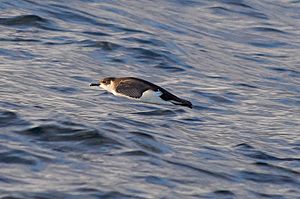Little shearwater facts for kids
Quick facts for kids Little shearwater |
|
|---|---|
 |
|
| Puffinus assimilis elegans | |
| Conservation status | |
| Scientific classification | |
| Genus: |
Puffinus
|
| Species: |
assimilis
|
| Subspecies | |
|
|
The little shearwater (Puffinus assimilis) is a small seabird that belongs to the petrel family. Even though its name sounds like "puffin," it's not related to puffins at all! The only thing they have in common is that they both dig burrows to make their nests.
Contents
What Does the Little Shearwater Look Like?
This bird flies in a special way, often called "shearing." It dips from side to side with its stiff wings, almost touching the water. It doesn't flap its wings much, especially when the wind is strong. When it flies, it looks like a cross shape. Its black back and white belly show alternately as it glides low over the sea.
Little shearwaters are about 25 to 30 centimeters (10 to 12 inches) long. Their wings can spread out to 58 to 67 centimeters (23 to 26 inches). They look a bit like a smaller version of the Manx shearwater. However, little shearwaters have shorter, wider wings. They also have a lighter area on the inner part of their flight feathers. Their beak is thinner than a Manx shearwater's, and their dark eyes stand out against their white face.
How Scientists Group Little Shearwaters
Scientists study birds to understand how they are related. They use clues like DNA to figure out their family trees. The little shearwater has some relatives that were once thought to be the same species. For example, the Boyd's shearwater and Barolo shearwater were once considered part of the little shearwater group. Now, many scientists believe they are their own distinct species.
Other birds like the Rapa shearwater and the subantarctic shearwater were also once thought to be the same as the little shearwater. This shows how scientists keep learning new things about birds and sometimes change how they classify them!
Where Do Little Shearwaters Live?
Little shearwaters live in different parts of the world, mostly around islands. Here are some of the places where different types of little shearwaters are found:
- The P. a. assimilis type lives near Lord Howe Island and Norfolk Island.
- The P. a. haurakiensis type lives in the northeastern part of North Island in New Zealand.
- The P. a. kermadecensis type lives in the Kermadec Islands.
- The P. a. tunneyi type lives on islands off southwestern Australia.
These birds make their homes in large groups called colonies. They build their nests in burrows on islands and along coastal cliffs. They only visit their burrows at night. This helps them stay safe from bigger birds like gulls that might try to eat them or their eggs.
Little Shearwater Life Cycle and Behavior
Little shearwaters are social birds. You can often see many of them together, especially during their migration in autumn. They find their food in the ocean, eating small fish and molluscs. Unlike some other seabirds, they don't follow boats.
When they are out at sea, little shearwaters are usually quiet. But when they return to their breeding colonies at night, it gets very noisy! They make loud, cackling calls.
For nesting, they choose cavities in grassy areas or among rocks. The female little shearwater usually lays one clear white egg. The egg is about 51 by 35 millimeters (2 by 1.4 inches) in size. Both the male and female birds take turns sitting on the egg to keep it warm. This incubation period lasts for about 52 to 58 days until the chick hatches.
See also
 In Spanish: Pardela chica para niños
In Spanish: Pardela chica para niños



